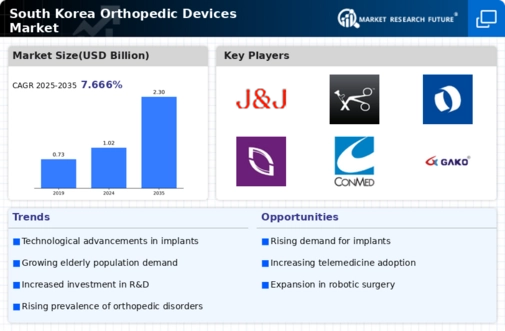Increased Awareness of Preventive Healthcare
There is a growing awareness of preventive healthcare among the South Korean population, which is influencing the orthopedic devices market. As individuals become more health-conscious, they are seeking ways to prevent musculoskeletal issues before they arise. This shift in mindset is leading to an increase in the use of orthopedic devices for preventive measures, such as braces and supports. Health campaigns promoting physical activity and proper ergonomics are contributing to this trend. The orthopedic devices market is likely to see a rise in demand for preventive products, potentially increasing market share by 5% over the next few years as consumers prioritize proactive health management.
Rising Incidence of Musculoskeletal Disorders
The orthopedic devices market in South Korea is experiencing growth due to the increasing prevalence of musculoskeletal disorders. Conditions such as osteoarthritis and rheumatoid arthritis are becoming more common, particularly among the aging population. According to recent health statistics, approximately 30% of adults over 65 in South Korea suffer from some form of arthritis, leading to a heightened demand for orthopedic devices. This trend is likely to continue as the population ages, with projections indicating that by 2030, the number of individuals aged 65 and older will exceed 20% of the total population. Consequently, the orthopedic devices market is expected to expand significantly to meet the needs of this demographic, driving innovation and investment in new treatment options.
Government Initiatives and Healthcare Policies
Government initiatives aimed at improving healthcare access and quality are positively influencing the orthopedic devices market in South Korea. The Ministry of Health and Welfare has implemented various policies to enhance the healthcare system, including increased funding for medical research and development. These initiatives are designed to support the adoption of advanced orthopedic technologies and improve patient outcomes. Furthermore, the government is promoting public awareness campaigns about musculoskeletal health, which may lead to earlier diagnosis and treatment. As a result, the orthopedic devices market is likely to benefit from increased demand for innovative solutions, with an estimated growth rate of 7% annually over the next five years.
Growing Investment in Research and Development
Investment in research and development (R&D) within the orthopedic devices market is on the rise in South Korea. Companies are increasingly allocating resources to develop new technologies and improve existing products. This trend is driven by the need for more effective and efficient treatment options for musculoskeletal disorders. In 2025, R&D spending in the medical device sector is projected to reach approximately $1 billion, reflecting a commitment to innovation. Collaborations between universities, research institutions, and industry players are fostering advancements in materials and design, which could lead to the introduction of next-generation orthopedic devices. This focus on R&D is expected to enhance the competitive landscape of the market.
Expansion of E-commerce and Digital Health Solutions
The orthopedic devices market is witnessing a transformation due to the expansion of e-commerce and digital health solutions in South Korea. With the rise of online shopping, consumers are increasingly purchasing orthopedic devices through digital platforms. This trend is facilitated by the convenience of online access and the availability of a wide range of products. Additionally, telemedicine and digital health applications are enhancing patient engagement and enabling remote consultations, which may lead to increased device utilization. As e-commerce continues to grow, it is anticipated that the orthopedic devices market will experience a shift in distribution channels, potentially increasing sales by 10% in the coming years.





















Leave a Comment